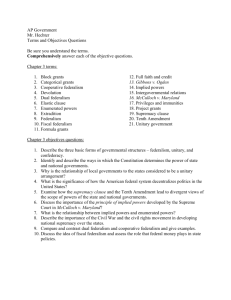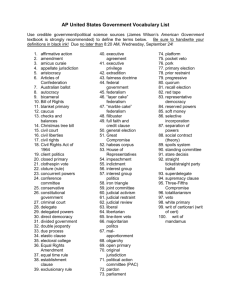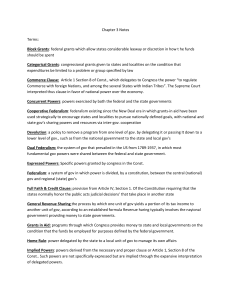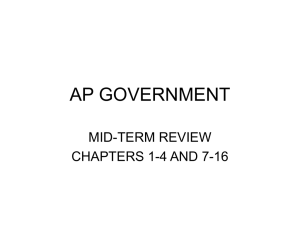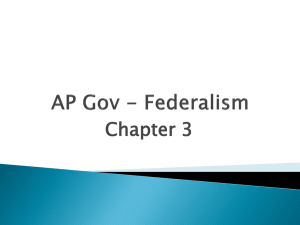ferderalism exam a
advertisement
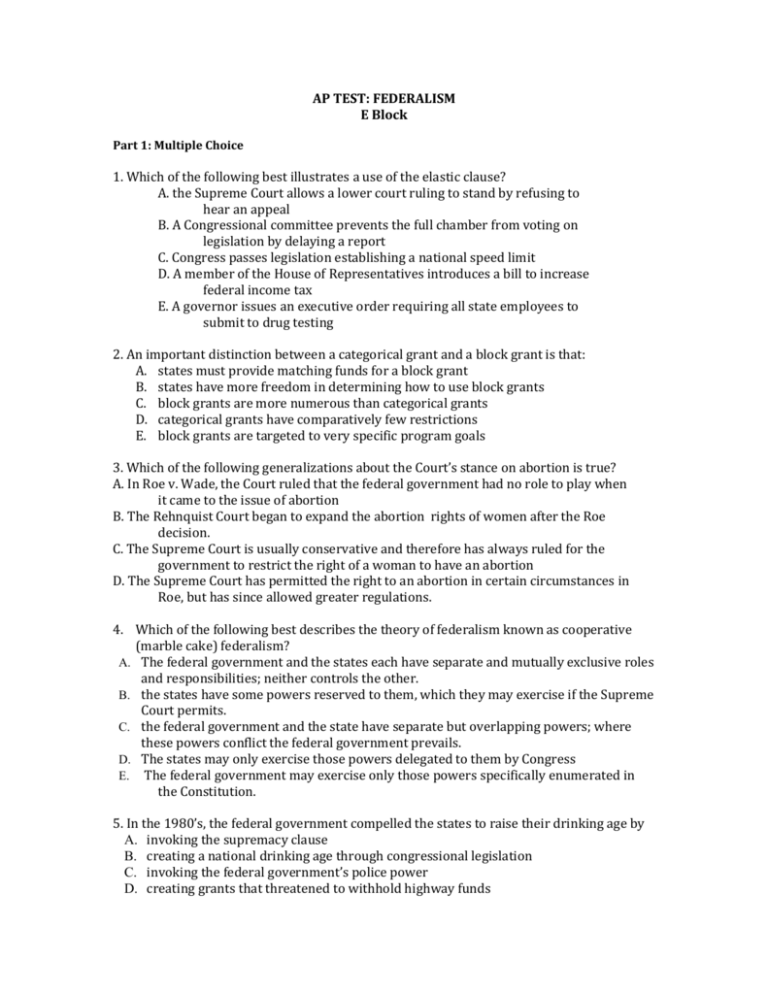
AP TEST: FEDERALISM E Block Part 1: Multiple Choice 1. Which of the following best illustrates a use of the elastic clause? A. the Supreme Court allows a lower court ruling to stand by refusing to hear an appeal B. A Congressional committee prevents the full chamber from voting on legislation by delaying a report C. Congress passes legislation establishing a national speed limit D. A member of the House of Representatives introduces a bill to increase federal income tax E. A governor issues an executive order requiring all state employees to submit to drug testing 2. An important distinction between a categorical grant and a block grant is that: A. states must provide matching funds for a block grant B. states have more freedom in determining how to use block grants C. block grants are more numerous than categorical grants D. categorical grants have comparatively few restrictions E. block grants are targeted to very specific program goals 3. Which of the following generalizations about the Court’s stance on abortion is true? A. In Roe v. Wade, the Court ruled that the federal government had no role to play when it came to the issue of abortion B. The Rehnquist Court began to expand the abortion rights of women after the Roe decision. C. The Supreme Court is usually conservative and therefore has always ruled for the government to restrict the right of a woman to have an abortion D. The Supreme Court has permitted the right to an abortion in certain circumstances in Roe, but has since allowed greater regulations. 4. Which of the following best describes the theory of federalism known as cooperative (marble cake) federalism? A. The federal government and the states each have separate and mutually exclusive roles and responsibilities; neither controls the other. B. the states have some powers reserved to them, which they may exercise if the Supreme Court permits. C. the federal government and the state have separate but overlapping powers; where these powers conflict the federal government prevails. D. The states may only exercise those powers delegated to them by Congress E. The federal government may exercise only those powers specifically enumerated in the Constitution. 5. In the 1980’s, the federal government compelled the states to raise their drinking age by A. invoking the supremacy clause B. creating a national drinking age through congressional legislation C. invoking the federal government’s police power D. creating grants that threatened to withhold highway funds E. ratifying the twenty-first amendment 6. The basic premise of federalism is that A. two or more governments share power and authority over the same land and people B. supreme executive power derives from a mandate from the masses C. supreme political authority remains with the states D. a national government has ultimate sovereignty over a country’s land and people E. states are sovereign unto themselves 7. A political system in which all the power is in the hands of the central known as a: A. confederal system B. unitary system C. federal system D. republican system E. state system government is 8. Someone who believes that the elastic clause of the Constitution should be narrowly interpreted is most likely to endorse the concept of _______ federalism. A. Dual B. Cooperative C. Creative D. Implied E. coercive 9. From the 1930’s to the 1970’s, The Supreme Court’s interpretation of the commerce clause generally served to A. preserve states’ rights B. increase national power C. have no consistent effect on national and state power D. leave the balance of power between the national and state governments unchanged E. decrease national power 10. Since the 1930s, the national government has controlled its grants to the states through detailed rules, regulations, and restrictions because A. national payments to the states are actually unnecessary B. the national government does not trust the states to use the money for the purpose for which it is given C. state governments are not interested in influencing the content of national legislation D. state bureaucracies have been shrinking in size E. the national government does not have the funding for these programs Questions 11-12 refer to the following excerpts from a United States Supreme Court decision. “We are unanimously of opinion, that the law passed by the legislature of Maryland, imposing a tax on the Bank of the United States, is unconstitutional and void...This is a tax on the government of the Union to carry its powers into execution. Such a tax must be unconstitutional...” 11. This decision of the Supreme Court upheld the principle that A. The federal government and the state governments are equal B. Congress has only those powers specifically enumerated in the Constitution C. Congress has the power to make laws to carry out its constitutional duties D. Taxation without representation is unconstitutional E. The federal government alone may levy taxes 12. Which of the following resulted from this Supreme Court decision? A. The power of the national government was strengthened B. The power of the Supreme Court was weakened. C. The power of state governments to tax individual citizens was clearly limited D. Congress was given the power to coin money E. Congress alone was given the power to charter banks 13. “Dual Federalism” refers to: A. the fact that there are separate private and public spheres in American society B. the Constitution’s formal recognition of two layers of government- the state and federal governments as two and distinct spheres of influence C. the fact that states that border foreign countries can establish trade treaties separately from the national government D. the fact that states all have equal power to regulate commerce between themselves. E. There is an overlapping sphere of influence between states and the national government A. B. C. D. E. 14. Most of the influence that the national government has over the states comes in the form of: grants-in-aid revenue sharing block grants applications of the “full faith and credit” clause the 10th amendment 15. Cooperative Federalism of the Great Society was characterized by: I. shared costs between the states and national government II. guidelines and rules set down by the federal government III. only one type of administration of programs IV. a strict interpretation of Article I, Section 8 A. B. C. D. E. I only II only I and II only I, II and III I, II, III, and IV 16. In Gibbons v. Ogden (1824), the Supreme Court ruled A. judicial review was a power of the court B. state contracts took precedence over federal law C. Congress had the exclusive right to regulate interstate commerce D. The states cannot tax the national government E. That New York state had a legitimate monopoly on the lower Hudson River 17. Which of the following is viewed as an advantage of the many governments that characterize American federalism? A. Having many governments ensures that all regions and localities are treated equally by the federal government B. Government fragmentation makes government as a whole more easily understood by the average citizen C. Historically state governments have been more responsive to minorities and the disadvantaged D. Having many governments enables the country to experiment with new policies on a small scale E. Having many different areas of government encourages gridlock in policymaking 18. The intended goal of the Republican Revolution on federalism was: A. The strengthening of the power of the national government B. The return to the strict separation between national and state responsibilities C. The acceleration of the ongoing shift of power back to the states D. The return of large-scale national government programs that were to be implemented by the states E. A Supreme Court that had a broad view of the elastic clause and commerce clause 19. Which aspect of fiscal federalism did Congress challenge with legislation after the Republican Revolution? A. block grants B. unfunded mandates C. funded mandates D. revenue sharing E. categorical grants 20. A. B. C. D. E. Which of the following reflect the devolution of federal power? an increase in the number of categorical grants to the states an increase in the number of unfunded mandate to the states executive orders increasing the size of the bureaucracy the Supreme Court broadly interpreting the elastic clause of the Constitution the increase of block grants given to the states 21. The Framers created the federal system in order to: A. preserve power for the elite in society B. establish a democratic political system that was also efficient C. establish a powerful central government and minimize the sovereignty of state and local governments D. prevent tyranny by dividing the powers of government E. allow factions to flourish and eventually control government 22. Article I, Section 8 gives Congress the power to pass all laws “necessary and proper” to carrying out its enumerated powers. This clause is also known A. enumerated powers clause B. reserve powers clause C. elastic powers clause D. full faith and credit clause E. supremacy clause as the: 23. Which of the following actions by the federal government best illustrates the concept of unfunded mandates? A. requiring that polling booths remain open beyond the hours of the workday B. requiring states and municipalities to provide certain services for their citizens without providing resources to pay of those services C. requiring all municipalities to impose a minimum property tax on all residential and business properties D. requiring state and municipalities to privatize many previously publicly funded services E. requiring state governments to guarantee short term bonds issued by large municipalities in their states 24. Federal policies to regulate food and drugs, build interstate highways, protect consumers, try to clean up dirty air and water, and do many other things are all justified as __________ of Congress. A. categorical grants B. constitutionally specified powers C. implied powers D. enumerated powers A. reserved powers 25. The Supreme Court first declared that the courts have the power to overturn government acts that conflict with the Constitution in A. Marbury v. Madison B. McCulloch v. Baltimore C. Gibbons v. Ogden D. US v. Lopez E. Plessey v. Ferguson 26. A marriage license issued in one state is valid and honored in all states under the constitutional provision of A. separation of powers B. full faith and credit C. privileges and immunities D. national supremacy E. checks and balances 27. The Supreme Court in the case of US v. Lopez (1995) ruled A. that a section of the Brady Bill was unconstitutional B. that Congress had exceeded its powers when it passed the Gun Free Zone Act C. that a key provision of the Violence Against Women ACT was unconstitutional D. that commerce could be defined as virtually anything Congress said it was E. that Congress could regulate the sale of guns under the Brady Bill 28. Enumerated powers of the federal government include all of the following EXCEPT the power to (A) coin money (B) declare war (C) regulate interstate commerce (D) regulate intrastate commerce (E) tax Hypothetical Government President Republican Senate 49 Republicans 51 Democrats House 220 Republicans 215 Democrats 29. The government depicted above is best described by which of the following terms? (A) Nonpartisan government (B) Unicameral government (C) Unitary government (D) Divided government (E) Federal government Part 2: Free Response – Answer completely: DO ALL PARTS OF THE QUESTION! (15 points) 28. The concept of federalism has undergone many changes throughout the history of American politics, often times changing the effects of policymaking in the US. Using your knowledge of American politics, complete the following tasks: A. Describe why the Framers chose to establish a federal system. B. Identify and describe 2 factors which cause the concept of federalism to change over time in American politics. C. Using one of the policies below, explain the major debate between the national and state governments, referring specifically to constituional provisions. D. Explain how the concept of federalism in the policy chosen in (c) has altered the relations between the states and national government in the last 25 years. Refer to fiscal federalism and all relevant legislation and/or judicial decisions. Abortion Gay Marriage Medical Marijuana


